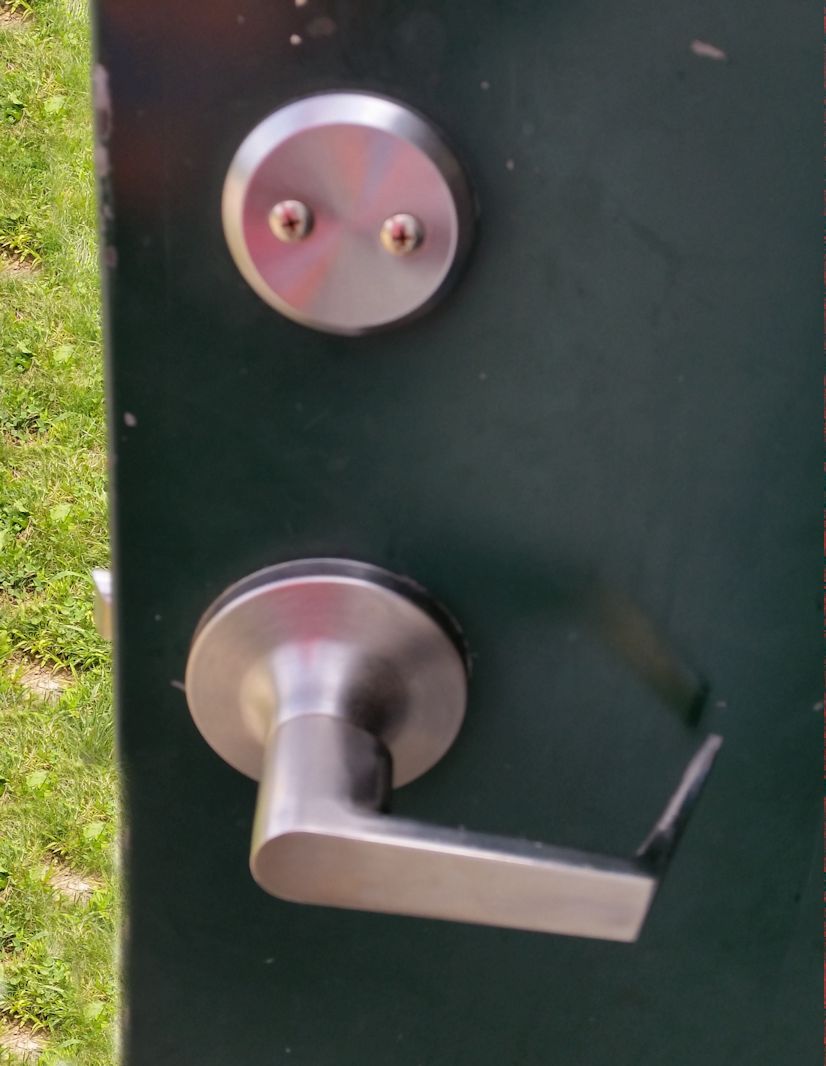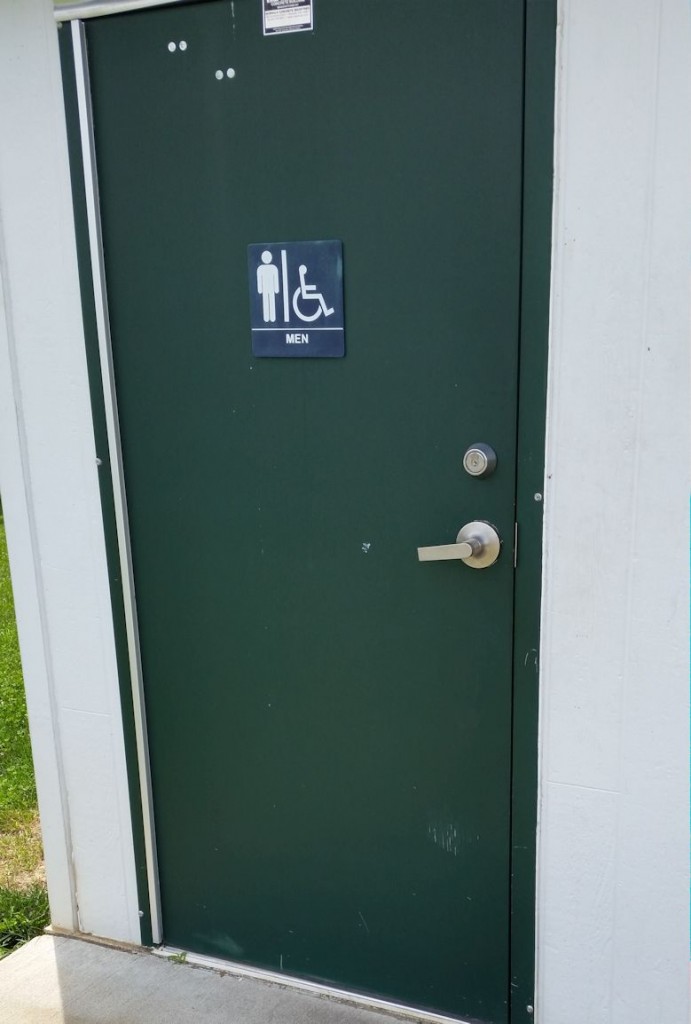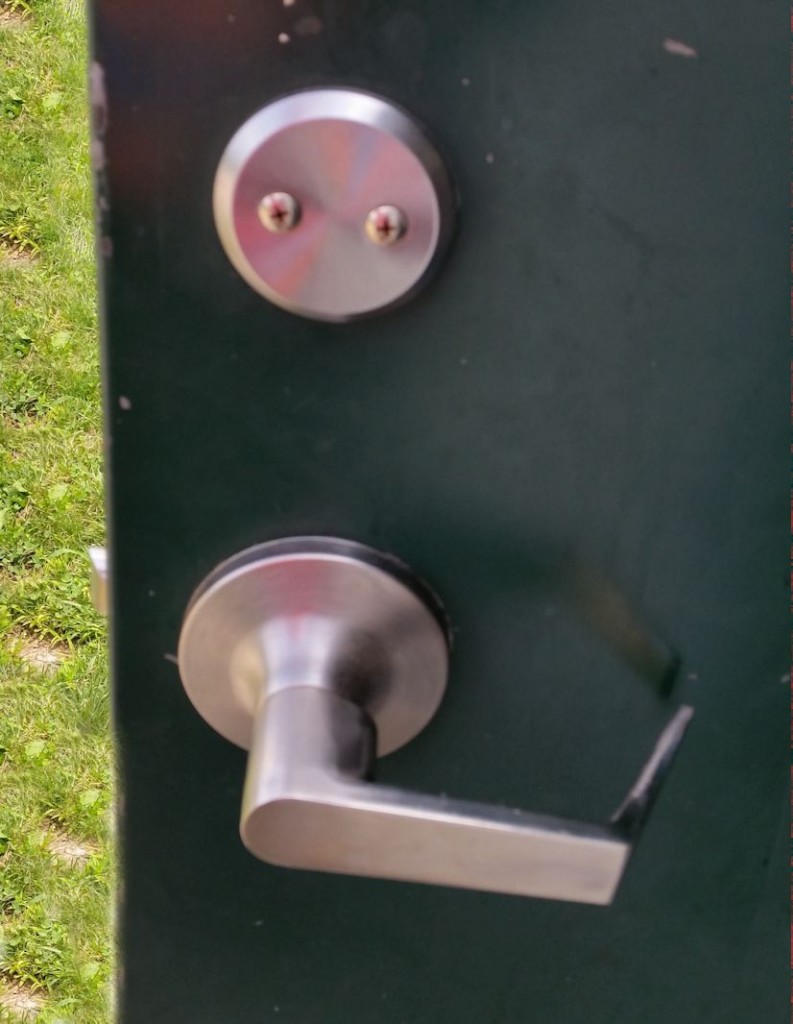I’ve received several photos lately of restroom doors with non-code-compliant deadbolts. Some examples of this problem could be:
- A deadbolt with a blank plate (or nothing) inside and a key cylinder outside – an occupant could be locked in the bathroom by someone using a key.
- A deadbolt with a key cylinder both sides – a key cylinder on the egress side of a door is only permitted in very limited situations and a bathroom would not be one of the acceptable locations.
- A lever handle latchset with a separate deadbolt – the door will not unlatch with one operation if the deadbolt is thrown.
.
I was also at a meeting with code experts (not hardware experts) recently where we were talking about deadbolts; several people checked out the deadbolt on the bathroom door and reported that it was broken. Without even going to look at it I knew that it was a classroom function deadbolt. With this function, the interior thumbturn will retract the bolt if someone locks the door from the outside using the key when someone is inside the room. The interior thumbturn will not project the bolt, so if the door is not locked the interior thumbturn appears to be broken even though it’s working as designed.
Here are my own personal rules for using deadbolts:
- On a multi-stall bathroom, I use a classroom deadbolt (inside thumbturn retracts bolt but will not project it), unless the facility wants to use the bathrooms as a safe haven during a lockdown and then I use a classroom deadbolt with a key cylinder inside and outside (staff with a key can lock themselves into the bathroom during the lockdown, anyone can retract the bolt with the thumbturn or key).
- The deadbolt must be the only locking/latching hardware on the door – no separate latchset.
- The deadbolt must be mounted between 34 inches and 48 inches above the floor.
- The thumbturn must be operable with no tight grasping, tight pinching, or twisting of the wrist, and no key, tool, special knowledge or effort.
- A deadbolt with a key cylinder on the egress side (and no thumbturn) is only allowed in very limited applications, and a restroom is not one of them.
- If the door is a fire door, the door must have a positive latch and if a deadbolt is desired it must be an integral part of the latchset so turning the lever will retract the deadbolt and latchbolt.
- On a single occupancy toilet I use either a privacy set or a locking function with an occupancy indicator – not a separate deadbolt as this is not compliant with the requirement for hardware to unlatch with one operation.
.
Questions for you:
-
Do you have any additional rules I should add to my list?
-
If you saw a non-code-compliant deadbolt in a restroom at a rest area, what would you do about it?
-
How do we inform locksmiths who are installing deadbolts on existing doors and may not understand the code requirements?
You need to login or register to bookmark/favorite this content.








Your last two bulleted items are the only items I would allow, even if the bathroom door is not a fire door. Each allows for free egress at all times while providing security from unwanted entry when the ‘lock’ is engaged.
Why not a deadbolt with an accessible thumbturn and no other lock/latch?
An occupancy indicator deadbolt like Schlage B571 is acceptable on a single occupancy toilet where key locking is not required. Such doors typically have a door closer and no other latch and can thus [color=#FF6666]unlatch with one operation[/color].
Question: where is this mentioned in the code, specifically, restroom doors requiring one motion to exit?
Hi Eric –
The codes don’t specifically reference various types of rooms, but I did investigate this, and I wrote about it here: http://idighardware.com/2011/02/single-operation-egress/
– Lori
Thanks!
It’s a constant battle trying to educate folks (including other locksmiths) about the single action to unlatch code requirements. I came across a Schlage CS series lock recently that had an indicator deadbolt and thought “Hallelujah – Schlage is finally making an interconnected indicator lockset!” Upon inquiry however I was told that it must have been custom made. (Which is what we have done for many years with B571’s & S200 series locks.) Please wave your magic wand and convince the powers that be that interconnected indicator locks with passage and storeroom functions should be standard items in the catalog.
I’ll see what I can do!
I am a locksmith. I have seen hundreds of restrooms in schools in central Ohio with one sided deadbolts, (key side). I figured that there was an exemption to the code for restrooms in public schools. FYI. I only install classroom function deadbolts in those situations.
Hi Dave –
I have never seen an exception that would allow a one-sideded deadbolt. Classroom deadbolts are the way to go.
– Lori
ok, looking at these two pics, you have to do a double take to
make sure that with the door on the left, that it doesn’t have
a border of grass on both sides of it, but looking at the left
side of the left door, the door does have a frame and then what
appears to be a border of grass.. i guess that can happen when
a photo is cropped..
Would a deadbolt with a key cylinder on the outside, a thumb turn on the inside and a touch latch be allowed in a single occupant ADA restroom? Technically when you’re inside and turn the deadbolt to unlatch, you only need to push the door for it to open…
Hi Aga –
I’m not sure what product you’re referring to as a touch latch, but with regard to thumbturn deadbolts, my opinion is that they are acceptable if all of the following are true:
a) The door is not required to have panic hardware
b) The door is not fire rated (would require positive latching)
c) The deadbolt is the only lock/latch on the door so the latch/bolt is retracted with one operation (except dwelling unit entry doors)
d) The deadbolt is mounted between 34-48 inches above the floor
e) The thumbturn operates with no tight grasping, tight pinching, or twisting of the wrist and no key/tool/special knowledge or effort – I would test this by using the side of my palm or the tip of a pencil
– Lori